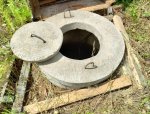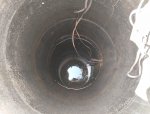Reading through this thread, I see you have received some good advice and some irrelevant advice.
My system is a typical pump in the bottom of the well,
That is called a submersible pump. As opposed to a jet pump or piston pump where the pump is at the surface. A submersible pump system cannot suck air into the piping as the piping is always under presssure -- any leaks will result in water leaking out. The only way for a submersible pump to introduce air into the system is drawing the water level down so low the pump itself sucks air into the intake.
which goes thru a pressure tank set at 40 PSI on the surface.
That is a typical pre-set pressure. But as mentioned earlier in the thread it should be adjusted to 2 psi below the cut-in pressure of the pump (ie: the lowest water pressure when the pump kicks in). So if the pump's pressure switch is set to cut in at 40 psi and cut out at 60psi, the air pressure in the bladder tank should be adjusted to 38psi. This will ensure maximum use of the water space without damage to the air bladder.
I've been getting air in the water lines which is evident by sputtering water.
Usually when taking a shower.
One way to get air in the lines is bacterial growth in the hot water heater -- usually accompanied by bad odours like rotten eggs. But that would be noticed all the time, since the outlet of the water heater is at the top and air rises.
I think the most likely source is the suction of your submersible pump, particularly since the problem is most noted during a high use event such as taking a shower. Also since you are now observing turbidity in the water which was not previously present.
Several have noted that the water level above the pump intake is important -- and it is. However, the height is only half the equation. Equally important is the recovery rate -- ie: how fast can you pump water out of the well without lowering the level substantially?
Let us say, for the sake of example, that you have 5' of water above the pump in a 6" well casing. That is about 7 gallons. And let us say that your shower delivers 2-1/2 gallons per minute. If the well has an extremely low recovery rate, you will draw the 5' off in about 3 minutes. If your well has a recovery rate of at least 2.5GPM, you will never draw the water down to the pump because the well will refill as fast as you are drawing it off.
If you draw the water level down close to the pump, it tends to form vortices (just like water going down a drain) which start to draw air and also stirs up sediment which is also drawn in, causing turbidity in the water at your tap. Ie: cloudy water in your glass.
this is a very wet area in the forest. We have a year around stream and local marshland.
Lots of water at the surface. But elsewhere you note it is a deep well -- and that is probably true since you have a submersible pump rather than a less expensive jet pump. What's between the surface and the bottom of the well? The fact that the water does accumulate at the surface rather than drain away suggests the intervening earth is rather impermeable -- rock or clay or similar. If it was a big pile of sand, the water would drain away and you wouldn't need a deep well in the first place.
It may take months, years or hundreds of years for that water at the surface to reach the aquifer. Your recovery rate will depend greatly on factors like how permeable that aquifer layer is and how much water are others in the area drawing from that aquifer.
Records from when the well was drilled should include the recovery rate at that date. If the recovery rate has diminished, it is an indication that the local aquifer is being depleted faster than it can supply. While one individual household will not have a significant impact, it should be a wake-up call for everyone in the area to limit their demands on the shared resource.
Shorter showers, flow restricted shower heads, low-flow toilets, etc will all help both your immediate situation with your personal well, but if everyone gets on board it will help maintain the aquifer itself. But good luck with that -- all too many people would rather stick their head in the sand and/or claim restrictions on water use are an attempt to undermine their individual freedoms.
Drilling a deeper well might access more depth of aquifer, but that is an expensive solution that only contributes to the overall problem of draining the aquifer for everyone.
3> The water heater is going bad. The water heater is 30 years old. It's not leaking at all. Seems to work fine.
They all seem to work fine until the day they fail ;-). How often do you check/replace the zinc anode inside the water tank? If you are like most homeowners, you just said "The
what ???"
On the top of the water tank will be a "plug", with a large hex head and usually screwed into a 3/4" or 1" female pipe thread outlet. That "plug" is actually a long sacraficial rod, maybe 3' long. The purpose of that rod is to corrode, preventing the steel tank from corrosion. Same principle as zinc anodes on boat hulls and outboard motors. If it is maintained, the tank itself will last indefinitely. If it is ignored, the tank will eventually fail. How long it will last is dependent upon your specific water PH, etc. Typically 2 to 5 years. Some larger tanks have 2 rods.




